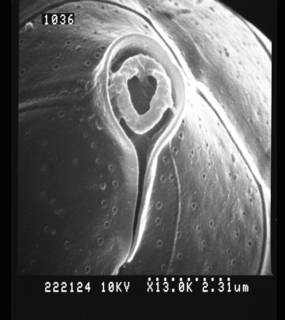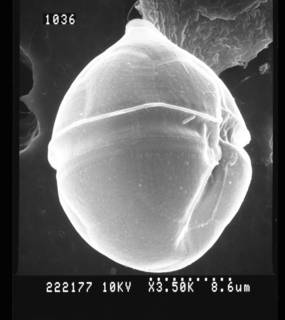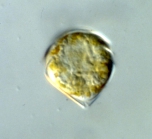Scheldt species taxon details
Scrippsiella acuminata (Ehrenberg) Kretschmann, Elbrächter, Zinssmeister, S.Soehner, Kirsch, Kusber & Gottschling, 2015
1321853 (urn:lsid:marinespecies.org:taxname:1321853)
accepted
Species
marine
Not documented
Guiry, M.D. & Guiry, G.M. (2025). AlgaeBase. World-wide electronic publication, National University of Ireland, Galway (taxonomic information republished from AlgaeBase with permission of M.D. Guiry). Scrippsiella acuminata (Ehrenberg) Kretschmann, Elbrächter, Zinssmeister, S.Soehner, Kirsch, Kusber & Gottschling, 2015. Accessed through: VLIZ Consortium Scheldt Species Register at: https://www.scheldemonitor.nl/speciesregister/aphia.php?p=taxdetails&id=1321853 on 2025-09-11
VLIZ Consortium. Scheldt Species Register. Scrippsiella acuminata (Ehrenberg) Kretschmann, Elbrächter, Zinssmeister, S.Soehner, Kirsch, Kusber & Gottschling, 2015. Accessed at: https://www.scheldemonitor.org/speciesregister/aphia.php?p=taxdetails&id=1321853 on 2025-09-11
Date
action
by
basis of record
Guiry, M.D. & Guiry, G.M. (2025). AlgaeBase. <em>World-wide electronic publication, National University of Ireland, Galway.</em> searched on YYYY-MM-DD., available online at http://www.algaebase.org [details]
new combination reference Kretschmann, J.; Elbrächter, M.; Zinssmeister, C.; Soehner, S.; Kirsch, M.; Kusber, W.-H.; Gottschling, M. (2015). Taxonomic clarification of the dinophyte Peridinium acuminatum Ehrenb., ≡ Scrippsiella acuminata, comb. nov. (Thoracosphaeraceae, Peridiniales). <em>Phytotaxa.</em> 220(3): 239., available online at https://doi.org/10.11646/phytotaxa.220.3.3 [details]
ecology source Hansen, P. J.; Tillmann, U. (2020). Mixotrophy in Dinoflagellates: Prey Selection, Physiology and Ecological Importance in Dinoflagellates: Classification, Evolution, Physiology and Ecological Significance. <em>Ed: Subba Rao Durvasula. Publisher: Nova Science Publishers, Inc. New York, USA.</em> [details]
ecology source Jeong, H.; Yoo, Y.; Park, J.; Song, J.; Kim, S.; Lee, S.; Kim, K.; Yih, W. (2005). Feeding by phototrophic red-tide dinoflagellates: five species newly revealed and six species previously known to be mixotrophic. <em>Aquatic Microbial Ecology.</em> 40: 133-150., available online at https://doi.org/10.3354/ame040133 [details]
ecology source Leles, S. G.; Mitra, A.; Flynn, K. J.; Tillmann, U.; Stoecker, D.; Jeong, H. J.; Burkholder, J.; Hansen, P. J.; Caron, D. A.; Glibert, P. M.; Hallegraeff, G.; Raven, J. A.; Sanders, R. W.; Zubkov, M. (2019). Sampling bias misrepresents the biogeographical significance of constitutive mixotrophs across global oceans. <em>Global Ecology and Biogeography.</em> 28(4): 418-428., available online at https://doi.org/10.1111/geb.12853 [details] Available for editors
ecology source Mitra, A.; Caron, D. A.; Faure, E.; Flynn, K. J.; Leles, S. G.; Hansen, P. J.; McManus, G. B.; Not, F.; Do Rosario Gomes, H.; Santoferrara, L. F.; Stoecker, D. K.; Tillmann, U. (2023). The Mixoplankton Database (MDB): Diversity of photo‐phago‐trophic plankton in form, function, and distribution across the global ocean. <em>Journal of Eukaryotic Microbiology.</em> 70(4)., available online at https://doi.org/10.1111/jeu.12972 [details]
ecology source Jeong, H.; Park, J.; Nho, J.; Park, M.; Ha, J.; Seong, K.; Jeng, C.; Seong, C.; Lee, K.; Yih, W. (2005). Feeding by red-tide dinoflagellates on the cyanobacterium Synechococcus. <em>Aquatic Microbial Ecology.</em> 41: 131-143., available online at https://doi.org/10.3354/ame041131 [details]
new combination reference Kretschmann, J.; Elbrächter, M.; Zinssmeister, C.; Soehner, S.; Kirsch, M.; Kusber, W.-H.; Gottschling, M. (2015). Taxonomic clarification of the dinophyte Peridinium acuminatum Ehrenb., ≡ Scrippsiella acuminata, comb. nov. (Thoracosphaeraceae, Peridiniales). <em>Phytotaxa.</em> 220(3): 239., available online at https://doi.org/10.11646/phytotaxa.220.3.3 [details]
ecology source Hansen, P. J.; Tillmann, U. (2020). Mixotrophy in Dinoflagellates: Prey Selection, Physiology and Ecological Importance in Dinoflagellates: Classification, Evolution, Physiology and Ecological Significance. <em>Ed: Subba Rao Durvasula. Publisher: Nova Science Publishers, Inc. New York, USA.</em> [details]
ecology source Jeong, H.; Yoo, Y.; Park, J.; Song, J.; Kim, S.; Lee, S.; Kim, K.; Yih, W. (2005). Feeding by phototrophic red-tide dinoflagellates: five species newly revealed and six species previously known to be mixotrophic. <em>Aquatic Microbial Ecology.</em> 40: 133-150., available online at https://doi.org/10.3354/ame040133 [details]
ecology source Leles, S. G.; Mitra, A.; Flynn, K. J.; Tillmann, U.; Stoecker, D.; Jeong, H. J.; Burkholder, J.; Hansen, P. J.; Caron, D. A.; Glibert, P. M.; Hallegraeff, G.; Raven, J. A.; Sanders, R. W.; Zubkov, M. (2019). Sampling bias misrepresents the biogeographical significance of constitutive mixotrophs across global oceans. <em>Global Ecology and Biogeography.</em> 28(4): 418-428., available online at https://doi.org/10.1111/geb.12853 [details] Available for editors
ecology source Mitra, A.; Caron, D. A.; Faure, E.; Flynn, K. J.; Leles, S. G.; Hansen, P. J.; McManus, G. B.; Not, F.; Do Rosario Gomes, H.; Santoferrara, L. F.; Stoecker, D. K.; Tillmann, U. (2023). The Mixoplankton Database (MDB): Diversity of photo‐phago‐trophic plankton in form, function, and distribution across the global ocean. <em>Journal of Eukaryotic Microbiology.</em> 70(4)., available online at https://doi.org/10.1111/jeu.12972 [details]
ecology source Jeong, H.; Park, J.; Nho, J.; Park, M.; Ha, J.; Seong, K.; Jeng, C.; Seong, C.; Lee, K.; Yih, W. (2005). Feeding by red-tide dinoflagellates on the cyanobacterium Synechococcus. <em>Aquatic Microbial Ecology.</em> 41: 131-143., available online at https://doi.org/10.3354/ame041131 [details]
PlanktonNet Image (from synonym Scrippsiella trochoidea (F.Stein) A.R.Loeblich III, 1976)
Published in AlgaeBase (from synonym Scrippsiella trochoidea (F.Stein) A.R.Loeblich III, 1976)
(from synonym Scrippsiella trochoidea (F.Stein) A.R.Loeblich III, 1976)
Published in AlgaeBase
To Barcode of Life (8 barcodes) (from synonym Scrippsiella trochoidea (F.Stein) A.R.Loeblich III, 1976)
To Biodiversity Heritage Library (9 publications) (from synonym Scrippsiella trochoidea (F.Stein) A.R.Loeblich III, 1976)
To Dyntaxa (from synonym Scrippsiella trochoidea (F.Stein) A.R.Loeblich III, 1976)
To European Nucleotide Archive, ENA (Scrippsiella acuminata)
To European Nucleotide Archive, ENA (Scrippsiella trochoidea) (from synonym Scrippsiella trochoidea (F.Stein) A.R.Loeblich III, 1976)
To GenBank (170 nucleotides; 27 proteins) (from synonym Scrippsiella trochoidea (F.Stein) A.R.Loeblich III, 1976)
To GenBank (65 nucleotides; 1 proteins)
To Global Biotic Interactions (GloBI) (from synonym Scrippsiella trochoidea (F.Stein) A.R.Loeblich III, 1976)
To NMNH Extant Collection (222124.jpg) (from synonym Scrippsiella trochoidea (F.Stein) A.R.Loeblich III, 1976)
To NMNH Extant Collection (222177.jpg) (from synonym Scrippsiella trochoidea (F.Stein) A.R.Loeblich III, 1976)
To PESI (from synonym Scrippsiella trochoidea (F.Stein) A.R.Loeblich III, 1976)
Published in AlgaeBase
 (from synonym Scrippsiella trochoidea (F.Stein) A.R.Loeblich III, 1976)
(from synonym Scrippsiella trochoidea (F.Stein) A.R.Loeblich III, 1976)Published in AlgaeBase

To Barcode of Life (8 barcodes) (from synonym Scrippsiella trochoidea (F.Stein) A.R.Loeblich III, 1976)
To Biodiversity Heritage Library (9 publications) (from synonym Scrippsiella trochoidea (F.Stein) A.R.Loeblich III, 1976)
To Dyntaxa (from synonym Scrippsiella trochoidea (F.Stein) A.R.Loeblich III, 1976)
To European Nucleotide Archive, ENA (Scrippsiella acuminata)
To European Nucleotide Archive, ENA (Scrippsiella trochoidea) (from synonym Scrippsiella trochoidea (F.Stein) A.R.Loeblich III, 1976)
To GenBank (170 nucleotides; 27 proteins) (from synonym Scrippsiella trochoidea (F.Stein) A.R.Loeblich III, 1976)
To GenBank (65 nucleotides; 1 proteins)
To Global Biotic Interactions (GloBI) (from synonym Scrippsiella trochoidea (F.Stein) A.R.Loeblich III, 1976)
To NMNH Extant Collection (222124.jpg) (from synonym Scrippsiella trochoidea (F.Stein) A.R.Loeblich III, 1976)
To NMNH Extant Collection (222177.jpg) (from synonym Scrippsiella trochoidea (F.Stein) A.R.Loeblich III, 1976)
To PESI (from synonym Scrippsiella trochoidea (F.Stein) A.R.Loeblich III, 1976)




